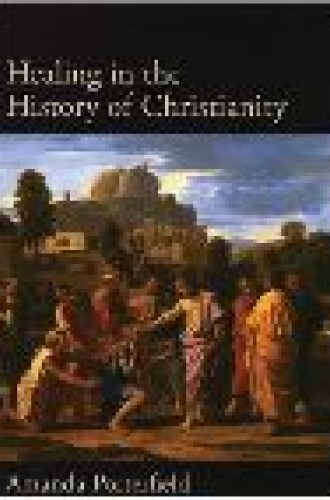Healing in the History of Christianity
I accept religious healing as a real biological phenomenon, although one prey to pious exaggeration,” writes Amanda Porterfield, professor of religion at Florida State University. She contends that “healing has persisted over time and across cultural spaces as a defining element of Christianity and a major contributor to Christianity’s endurance, expansion and success.” A book supporting this thesis would probably not have been written 50 years ago, much less published by a major university press. The rigid modernist dichotomies between matter and spirit, mind and body, religion and science have been melting in the postmodern milieu.
Porterfield’s claim is breathtaking in its reach and audacity. One is tempted to suspect that she came to the history of Christianity with healing-tinted glasses and something to prove. But the study, even-handed and far-reaching in scope (it ranges across history, cultures, geography and intellectual and theological movements), is made persuasive not by polemics or categorical declarations, but by Porterfield’s incisive analysis of the cumulative evidence.
Christian healing is located on one of the deep fault lines between science and religion, a boundary region prone to friction and misunderstanding. Porterfield knows the territory well, and she builds her case for the vitality of healing in Christianity by digging deep enough to discover the living bedrock of a healing tradition that unites its many apparently contradictory manifestations.
Porterfield examines subjects as diverse as medieval exorcism and present-day technological medicine; the Christian medical missionary movement and Pentecostalism; political healing in South Africa and baptism as a healing victory over evil; the placebo effect and the power of prayer; the Taiping Rebellion in China and the independent Harrist Church of Africa. She discusses the work of Hildegard of Bingen, John Calvin, Albert Schweitzer, John Wesley and Aimee Semple McPherson. Porterfield adeptly shows that the healing emphasis has adjusted to different historical periods and cultural contexts. For instance, 20th-century Pentecostals borrowed the language of electricity, radio waves and gravity to talk about the Holy Spirit, supplementing the rhetoric of the Gospels and Acts with terms of science and technology.
Liturgical historian Paul Bradshaw employs the terms lumpers and splitters to describe the two primary methodological orientations in the study of church history. Lumpers find among diverse practices a coherent tradition or development; splitters prefer to celebrate diversity and break open fault lines. Healing in the History of Christianity falls unambiguously in the lumper category. This is the point on which Porterfield will likely be taken to task. She says she came to her position reluctantly: “I assumed my study would support the view held by a number of historians I admire that there are, in fact, many Christianities and that reference to Christianity as a singular phenomenon is at best a convenience and at worst an aggressive, simplistic form of wishful thinking.” But her research pushed her to argue instead “that attention to healing reveals remarkable similarities among different cultural expressions of Christianity and that healing has been a driving force” in the history of the faith.
This is neither a how-to book on healing nor a theology of healing. It is a history book that examines healing methods, theologies and cultures touched by the Christian message and explores how new ways of viewing and dealing with suffering and health have consistently emerged. Sometimes the history is unflattering, as when Western medical missionaries indiscriminately condemned indigenous forms of healing, but Porterfield writes nonpejoratively as she sorts through the historical evidence. As past president of the American Society of Church History and current coeditor of the journal Church History: Studies in Christianity and Culture, she brings all the tools of the trade to this book. With her numerous examples and illustrations, ample documentation and fresh analysis, her sweeping generalizations become credible.





